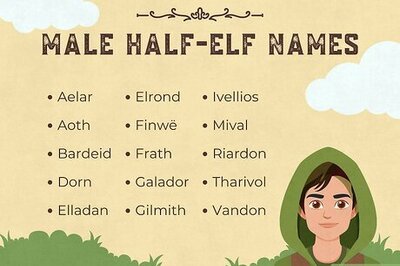
views
New Delhi: It's a long day of anticipation for K Sivan as the ISRO chief waits — like many others — with bated breath for Chandrayaan-2, India's ambitious lunar mission, to land on the moon in the early hours of Saturday.
Speaking to CNN-News18, Sivan said: "Yes I have butterflies in my stomach. I'm sitting at 'conversion desk' looking at preparations. We will wait for the great moment. PM Narendra Modi will be watching and it will be a big morale boost."
Chandrayaan-2's landing module 'Vikram' will begin its final descent to pull off a historic soft landing on the lunar surface in the early hours of Saturday, as the Indian Space Research Organisation waits for the "terrifying moment".
A successful landing will make India the fourth country after Russia, the US and China to achieve a soft landing on the moon. But it will be the first to launch a mission to the unexplored lunar south pole.
Joined by about 60-70 high school students from across the country, Prime Minister Narendra Modi will be present at the ISRO centre in Bengaluru to witness live the space feat, according to officials.
'Vikram' with rover 'Pragyaan' housed inside is scheduled for a powered-descent between 1 am and 2 am on September 7, followed by its touchdown between 1.30 am and 2.30 am. The lander is now in an orbit that would be about 35 km from the lunar surface at its nearest point from where it will begin its final descent.
ISRO has said Chandrayaan-2 will attempt to soft land the lander and rover in a high plain between two craters, Manzinus C and Simpelius N, at a latitude of about 70 south. ISRO Chairman K Sivan said the proposed soft landing on the Moon was going to be a "terrifying" moment as the ISRO has not done it before, where as Lunar Orbit Insertion (LOI) manoeuvre was successfully carried out during the Chandrayaan-1 mission.
Explaining the landing manoeuvres, Sivan had said once the manoeuvre starts from about 30 km to land on the surface of the moon, it will take 15 minutes. "This 15 minutes travel of lander is new to ISRO. It is for the first time we are going to another body where there is no atmosphere and using the propulsion system we will have to break the velocity and bring the vehicle safely to soft land.
To achieve this we will have to balance between the gravity and thrust. So we have to modulate the thrust of the engine," he had said. Following the landing, the rover 'Pragyaan' will roll out from 'Vikram' between 5.30 am and 6.30 am.
While, the 'Pragyaan' will carry out experiments on the lunar surface for a period of one lunar day, which is equal to 14 earth days, the main orbiter will continue its mission for a year. The lander and rover carry country's symbols on them, which will remain on the moon for long.
"The rover has six wheels (three each on both sides), the back two wheels- one has Ashoka Chakra on it and the other has ISRO emblem. Also, the ramp of the lander on which rover will come out and land on moon has Indian flag on it," Sivan had earlier said.
The Rs 978 crore unmanned moon mission (satellite cost Rs 603 crore, GSLV MK III cost Rs 375 crore) is expected to shed light on a completely unexplored section of the Moon — its South Polar region.
Pointing out that Chandrayaan 2 was going to South Pole, a place where nobody else has gone, ISRO Chairman K Sivan had said, the entire scientific community of the nation and the globe were eagerly waiting for the mission.
According to ISRO, the lunar South Pole is especially interesting because of the lunar surface area here that remains in shadow is much larger than that at the North Pole and there was a possibility of the presence of water in permanently shadowed areas around it.
In addition, South Pole region had craters that are "cold traps" and contain a fossil record of the early Solar System. India's Geosynchronous Satellite Launch Vehicle, GSLV MkIII-M1 had successfully launched the 3,840-kg Chandrayaan-2 spacecraft into the earth's orbit on July 22.




















Comments
0 comment